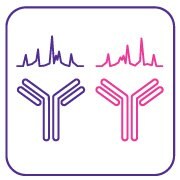Interlot & Biosimilar Comparability

Monoclonal antibodies (mAbs) are highly complex biomolecules, easily affected by changes within the biopharmaceutical manufacturing process. Even a simple temperature fluctuation can produce a change in higher order structure (HOS) that renders the mAb less active or inactive. If your mAb is an original product or a biosimilar, our comparability studies ensure robust and reproducible mAb production while establishing:
- Comparability between a biosimilar and an original product
- Comparability between different production facilities
Assay families that satisfy your testing needs
Molecular weight comparison: Molecular weight is a major indicator of mAb identity, influenced by the nature of the light and heavy chains as well as by post-translational modifications (PTM). Providing an indication of similarity to reference material, intact mass (IM) analysis is supported by studies to evaluate the molecular weight of individual chains, or to assess levels of glycosylation.
Amino acid analysis: Used to determine the amino acid composition of a mAb, amino acid analysis is a popular way to establish product identity. It is often performed alongside an extinction coefficient measurement, a method routinely employed to establish titer between different productions.
Sequence mapping: Sequence mapping varies considerably in its level of complexity. To gain an indication of the identity of your mAb, comparison of simple, single enzyme peptide maps may be sufficient; to better inform product engineering, N- or C-terminal sequencing may be performed. Mass spectrometry provides additional structural information.
Modification analysis: Many different post-translational modifications can occur during the mAb manufacturing process, which are greatly influenced by process parameters such as media and temperature. To produce a consistent product, it is important that these modifications are reproduced during every round of mAb synthesis. Modification analysis includes disulfide bridge mapping and evaluation of glycan basic structure. It is also wise to quantify sialylation, since sialic acid can have a negative effect on your mAb.
Product purity/impurity testing: The presence of impurities in your mAb product can present a serious risk, preventing regulatory approval from being granted. Size and charge variants can be identified using techniques such as dynamic light scattering (DLS) and UHPLC ion exchange. It is also wise to monitor the presence of residuals such as detergent, surfactant, protein, or DNA.
Potency/binding: Measurement of binding using Surface Plasmon Resonance (SPR) can provide rapid determination of binding, with the added benefit of kinetic information regarding association and disassociation rates. To thoroughly evaluate the potency of your mAb, relevant binding and cell-based assays should be implemented early in the drug development process to understand the biological functionality of all regions of the mAb molecule.
To discuss your comparability needs and take the next step in securing the future of your biotherapy, fill out the form below.
Fields indicated by an * are required.
To continue reading please sign in or create an account.
Don't Have An Account?


